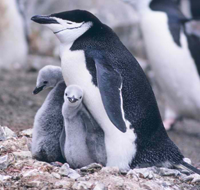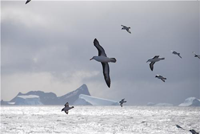Seabirds

The term "seabird" encompasses any bird species that spends a substantial part of its life in a marine environment, foraging and breeding. Birds within this class generally have a longer life span, breed later, and produce fewer young than other birds. Many seabird species are highly migratory, with some known to travel over 40,000 miles each year. Among the many types of seabirds are albatrosses, petrels, gulls, storks, and penguins. Seabirds depend on healthy oceans for their survival, and seabird populations can be quickly and significantly impacted by declines in ocean health. Because of this, scientists routinely use seabird population data as a barometer for ocean health.

Throughout history, humans have exploited seabirds for their oil, feathers, and meat; for centuries, mariners have used seabirds to locate fish shoals and find land. As the human population and its technological resources increase, the threats to seabirds are growing. In particular, "bycatch," or the incidental capture of non-target species such as seabirds in large-scale fishing operations has generated growing concern over the long-term ecological effects of commercial fishing methods and gear. In response to these concerns, NOAA implemented regulations and continues to engage with other countries in its efforts to mitigate the problem of seabird bycatch. These efforts, along with the bycatch mitigation efforts of the international community, have culminated in the Agreement on the Conservation of Albatrosses and Petrels (ACAP), an international agreement designed to ensure the long-term survival of many seabird species.
Additional reference information: ![]()
- News Articles
- Seabird Overview: Biology, Habitat, and Threats offsite link
- Pacific Seabird Group offsite link, Seabird Conservation Information
- NOAA Fisheries’ National Seabird Program with Additional Resources on National and International Initiatives

